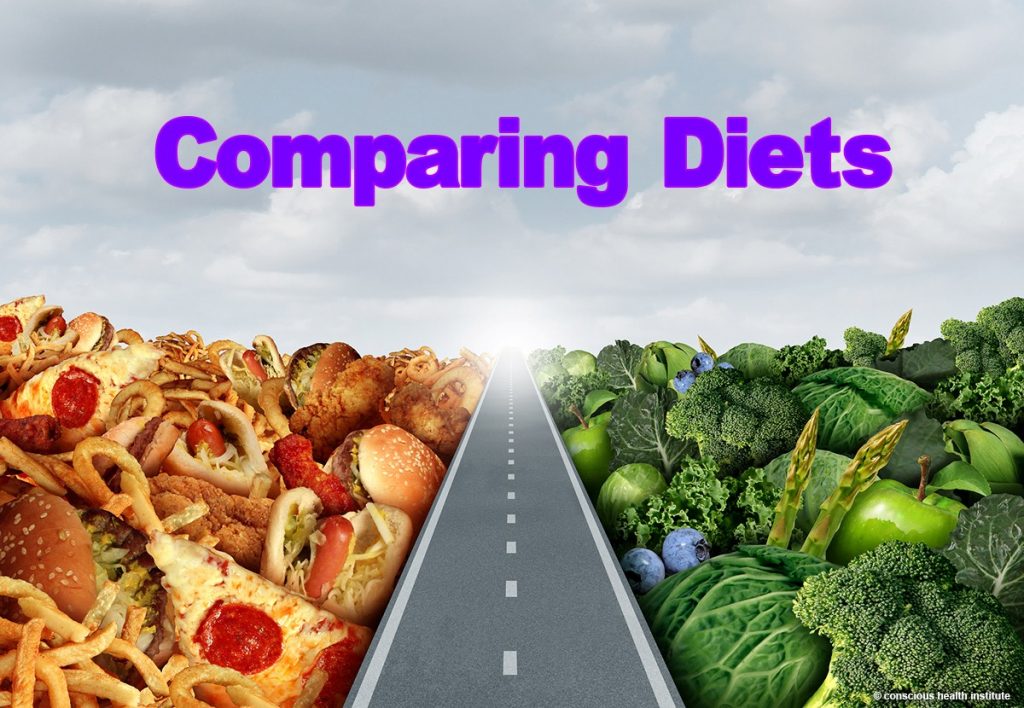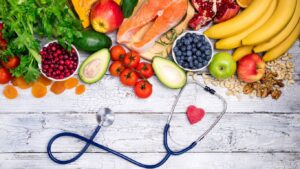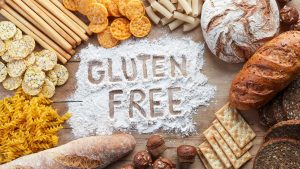There are so many dietary trends and fad dietsout there that it can be very difficult to decide which diet, if any, may be right for you.
Every two to three years, a newer, better diet will seemingly appear from nowhere and take the headlines by storm, occasionally with the backing of celebrity endorsement.
For you the readers, in trying to find the most sustainable and healthy way to lose weight and get your health back on track, it can be difficult to know which plan will live up to its promises and work, and which might not suit you at all.
In this article I will be comparing four popular dietary patterns to make the maze of information a bit easier to navigate through.
First we start with the Paleo diet.
Paleo diet
The Paleolithic diet, also known as the caveman diet, is based on the premise of pre-agricultural ‘hunter-gatherer’ foods. It features only those items which could be ‘caught’ or naturally gathered by paleolithic humans.
What does it involve?
The reliance on natural foods means the exclusion of:
- Processed meats
- Wheat and dairy
- Refined sugar
- Grain-based food
And the inclusion of:
- Lean meat
- Fish
- Fruit and vegetables
- Nuts and seeds
- Eggs
This naturally leads towards a diet which is high in protein and low in carbohydrates.
Pros
- The omission of processed foods means little in the way of calorie-dense meals, and more in the way of nutritious fruit and vegetables.
- Basic premise is one which is simple to follow, and does not require calorie budgeting.
- 80/20 options (where you stick to the rules 80 % of the time) allows for some flexibility.
Cons
- Dependent on high levels of meat consumption, and not suitable for vegetarians.
- Cuts out food groups such as dairy and grain, crucial aspects of a varied and balanced diet.
- The diet is not based on hard evidence (there are no accurate records of what paleolithic man used to eat) and more research is needed to determine its benefits.
In summary
The Paleo diet omits certain food groups that are essential, and might induce vitamin deficiencies as a result.
However, an adapted version of the Paleo diet which does not exclude dairy and grain may have significant nutritional value.
Those looking to lose weight through a variation of the Paleolithic diet should also make sure they’re getting enough exercise.
Keto Diet
Though not a new diet, the ketogenic diet has in recent months become more and more popular as a means for prompting weight loss. The ketogenic diet has been used for many years, mostly in clinical settings like hospitals, as part of the treatment protocol for children and adults suffering from epilepsy.
The ketogenic diet is extremely strict and requires following specific guidelines of about 25 to 35 grams of net carbohydrates (total carbs minus fibre) daily, about the equivalent of one apple. The rest of a ketogenic person’s diet is comprised of 5% protein and then fat for the remaining 70 to 80% of the calories.
The purpose of the ketogenic diet is to switch our bodies from using carbohydrates for fuel to burning ketones instead. When the body is starved of carbohydrates, fat is broken down and ketones are formed by the liver and then burned for energy instead of glucose. When followed strictly, the excess ketones that our bodies make can be measured in the urine; strict followers of the diet will sometimes check their urine to ensure they find ketones.
Pros
1. It reduces insulin levels (and inflammation).
Insulin is a key hormone that helps move glucose from the bloodstream to the muscles and tissues. Higher levels of circulating insulin have been linked to increased inflammation and the ketogenic diet may help to reduce insulin levels and thereby help to potentially reduce inflammation in the body.
2. It possibly leads to weight loss.
Some people, especially at first, often notice some weight loss. This is partially because of the increased satiety due to fat intake (fat slows digestion and promotes balanced blood sugar), partially because of more balanced blood sugar levels, but also because many people will cut out much of the sugar- and carb-heavy food they’re eating. These carb- and sugar-laden foods can contribute to water retention, so when that water weight goes away, people feel and look thinner.
3. You’ll end up eating more fat.
Fat is so crucial to health, and most of us really don’t get enough of it. One of the pros of this diet is increased fat, especially if it’s healthy fat from avocado, nuts, or wild fatty fish.
4. It’s a great way to detox from sugar.
Due to the fact that this diet allows only 25 to 35 grams of carbs total, most people will have to cut out their intake of really sugary foods, which is certainly a plus and something I think most of us can benefit from!
Cons
1. It can be quite difficult to follow.
It’s really difficult even for an expert like me to live my life and follow a plan that’s 70 to 80 percent fat, 10 percent carb, and 15 percent protein, as every single meal (for the most part) has to be planned and calculated. For most people this will be the hardest part.
2. Many people end up eating fats that aren’t so healthy.
While the upside of this plan is the increased fat intake, the downside is that many people actually end up eating a lot of highly saturated animal fats. Though the carbohydrates are out of the equation, making the fats potentially less dangerous, these types of fats aren’t health promoting. In addition, many people aren’t purchasing organic and/or grass-fed animal products, so quality of food can be an issue as well. Bottom line: if you’re using a lot of animal-based foods for fats and proteins, try to make them organic and well sourced whenever possible.
3. It may not promote significant long-term weight loss.
Though there is some weight loss for many (and even significant amounts for others), many people don’t lose as much as they would like to (perhaps because this dietary pattern is very hard to strictly stick to).
4. You won’t be eating as much heart-healthy, gut-healthy, satiating fibre.
Though this diet can be high in heart-healthy fats (depending on the ones you choose), it’s often low in fibre. It can also be lower in plant-based healthy nutrients, as many foods that contain fibre also contain more carbs than permitted on this type of plan.
In Summary
If you want to try the ketogenic diet here’s what I recommend:
- Choose the healthiest fats you can to make up the 70 to 80 %: egg, avocado and almonds are my favourite picks.
- Include as many greens as you can—they’re lower in carbs and packed with nutrients.
- Try to get organic/grass-fed animal products whenever you can, including cheeses, eggs, other dairy products, and animal meats of all kinds.
- Drink plenty of water. With more fat and less fibre (generally), you can get a little constipated, drinking more water can help with that
- Assess how you feel as you go and keep a journal of your progress that you can track.
5:2 diet
Modelled on the concept of intermittent fasting, the 5:2 or the Fast Diet is one of the most popular plans of recent years. It gained significant attention after being featured on BBC documentary Horizon in 2012.
What does it involve?
The person following the plan has five days a week of eating ‘normally’ and two days of ‘fasting’, but thankfully in this scenario fasting doesn’t mean not eating at all. On each of these two days, which should be observed non-consecutively, women are allowed no more than 500 calories and men 600.
This might be:
- A 300-calorie breakfast of two scrambled eggs with ham.
- And another meal later in the day of grilled fish and vegetables, again amounting to no more than 300 calories.
Pros
- Dieting for two days a week instead of seven is an easier task.
- The plan is effective at reducing calorie-intake and helping to lose fat.
- The rules are simple to follow.
Cons
- Cutting out meals on fasting days can cause headaches, irritability and tiredness, which can harm performance at work, and may also cause dehydration and vitamin deficiencies.
- Has been associated with problems sleeping at night.
- May lead to overeating on non-fast days.
- Not all versions of this plan are backed by scientific evidence.
In summary
More than one version of this diet exists, although they follow the basic premise of two drastically low-calorie days a week. It’s important to look up advice from a dietitian before attempting it, as some variations of the diet can be detrimental to health.
Furthermore, if you have a condition such as diabetes or if you are pregnant, then this diet will not be suitable for you.
Dukan diet
Put together by French doctor Pierre Dukan, this plan focuses on high protein and low carbohydrates. The rationale is that the body will be forced to burn fat due to the absence of carbohydrates, and weight loss is intended to start off quickly then become gradual.
What does it involve?
Four phases:
- The first, also known as the ‘attack’ phase, lasts for 1-10 days and involves eating lean protein (from an approved list). In addition to this, the user will also eat a tablespoon and a half of oat bran per day, and drink six glasses of water. No vegetables or other carbs are allowed.
- The ‘cruise’ phase comes next. During this phase which can last for a number of months, non-starchy vegetables can be reintroduced, along with an extra half teaspoon of oat bran.
- The third phase is ‘consolidation’. This is followed for five days per kg of weight lost. Vegetables are allowed each day, as is one serving of fruit and a serving of hard cheese. Two slices of whole grain bread per day are also permitted. On one or two occasions during this phase, the user is allowed a ‘celebration’ meal where any food is permitted.
- ‘Stabilisation’ is the last phase. From this point onwards in the plan, the user can eat as they please for six days a week. On the remaining day, they must observe the restrictions from the first phase and eat only lean protein. Three tablespoons of oat bran are eaten every day, and twenty minutes walking a day is also encouraged.
Pros
- The rapid rate of weight loss at the start of the plan may be a significant motivational factor for many.
- It’s easy to grasp and the user can refer to the approved foods list, without having to check calorie amounts.
- There is no limit on the amount of approved foods the user is permitted during the attack phase provided they follow the rules.
Cons
- The attack phase can be hard to sustain.
- A lack of carbs may cause tiredness and dizziness, and the lack of fibre from vegetables and grain could induce constipation.
- It may be unsuitable for those with certain health conditions (such as heart or kidney disease), and those with other conditions (such as diabetes) will need to consult with their doctor before embarking on this diet, as their medication administration may need to be adjusted.
In summary
The first phase of this diet is perhaps among the most difficult to follow, and the restrictions are such that it should certainly not be undertaken lightly by those with dietary conditions.
More research is needed to determine whether diets such as this one are sustainable and healthy in the long term.
Hopefully the information provided here will make it easier to make a more informed decision about which, if any, of the dietary patterns mentioned here are right for you. Before taking on any of these diets it’s best to consult your GP and local dietitian, especially if you have any conditions such as diabetes and heart problems, that may make it risky to follow certain dietary patterns.




